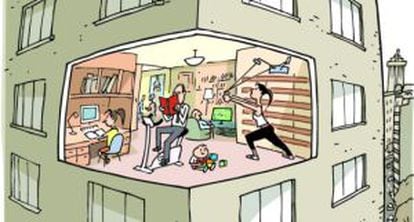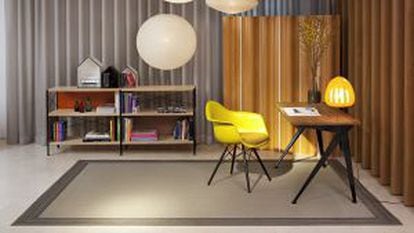Nine ways to warm up your home without turning on the heating
Spanish households should make the most of the sun to avoid paying sky-high energy bills

A study by the Institute for Energy Diversification and Savings (IDAE) shows that turning on the heating can represent 46 percent of a Spanish household’s energy consumption, leading to hefty bills at the end of each month.
That is why it pays to be aware of a few little tricks that can help warm up our homes without turning on the radiator.
“Houses by themselves do not propagate any heat, but our appliances generate temperature rises that can be taken advantage of, even if they are not very significant in cold weather,” says Manuel Barrera Viera, president of Andalusia’s Professional Association of Environmental Scientists.
“But the real key lies in solar energy,” he adds. “We need to bring the outside heat inside, and keep it there. And if we don’t have any internal heat production method, a lot will depend on the home’s insulation.”

1. Let the fresh air in, but don’t overdo it
Five minutes is all you need to air out a home, or 10 if the windows are really small. Don’t do it when it is really cold, though. “The best time is in the morning just after getting up,” explains Barrera Viera.
2. Divide and conquer
Zoning in the heat is essential, as it prevents the cold from expanding throughout the home. Get into the habit of closing the door of any room you are not using.
3. Don’t turn your back on the sun
When the sun hits your home, all windows and outside doors should be shut, and all obstacles such as curtains and blinds removed in order to let the light in. When the sun moves away from a room, do the opposite: roll down the blinds and pull the drapes shut to prevent the infrared radiation heat from disappearing.
4. Duct tape is your friend
Duct tape is an inexpensive way to seal cracks and improve the insulation of any windows and doors that do not shut properly. “It takes away that feeling that there’s an air current coming in from somewhere,” says Barrera Vieira.
5. Choose your trees wisely
If you have a garden, try to avoid trees whose leaves may block the sun’s rays and prevent them from entering your home. Barrera Vieira recommends deciduous species, as does Rafael Salmerón, director of the Madrid gardening center Los Peñotes. “In mild climates such as Spain’s, deciduous trees work better because they allow the insulation of façades and protect from the wind in the winter, and help keep places cool in the summer,” he says. “Creepers also help isolate walls.”
6. Colors that set more than the mood
The darker an object, the more heat it absorbs. A study by Campinas State University in São Paulo, Brazil, shows that black absorbs 98 percent of the heat it receives, followed by grey (90 percent) and dark green (79 percent). Perhaps getting a dark-colored couch for those winter afternoons is not such a bad idea.
7. Magic carpets

“Floors are the building element with the greatest energy loss. In winter, average floor temperature is 10° or 12°C, while in the summer it rises to 14° to 16°C,” says Barrera Viera, who recommends using rugs if you do not have wall-to-wall carpeting or wooden floors.
8. An exercise bike at home?
In the winter, people with bad circulation feel the cold more intensely. That is why practicing sports is a good way to improve the blood flow and feel warmer. “We’re not asking an elderly person to go out running, but we do say that he or she should move as much as possible, to allay the feeling of cold,” says Barrera Vieira.
“Exercise produces heat because the body consumes metabolic energy, which transforms into higher body temperature,” says Ángel Luis García Villalón, a physiology professor at Madrid’s Autonomous University. When you work out, your muscles’ arteries open up to increase the blood flow. But the activity has to be significant enough to produce this bodily change. “Walking does not lead to a higher body temperature, but running or pedaling does, even if it’s an exercise bike,” he says.
9. Blanket: don’t be home without it
Is there anything more typical than a winter afternoon on the sofa with a blanket and a movie? According to García Villalón, blankets made with animal hide are “the most efficient insulators,” but wool is also a good alternative and can absorb up to 30 percent of its own weight in water without conveying a sense of humidity, according to a 2009 study from Argentina. Synthetic fibers are a modern option that also work well. Lighting candles can make a room seem cozier, but will not raise the ambient temperature.
The tragedy of energy poverty
A 2012 report coordinated by the Environmental Science Association determined that around 10% of Spanish households, representing approximately four million people, are in a situation of energy poverty.
The document adds that this insufficient access to energy sources may already be causing more deaths than road accidents in Spain.
The study distinguishes between two types of energy poverty; the first affects low-income homes in the colder regions of Spain, in the central and northern provinces, which have heating systems but cannot afford the bills; the second one involves areas with a milder climate where many homes are not properly insulated and lack adequate heating systems in the event of a cold spell.
Spain lacks a well-defined strategy to combat energy poverty. Britain, the only country in the world with a specific policy, defines a household as living in energy poverty if it has to devote over 10% of its income on achieving a satisfactory indoor temperature (21ºC in the main room and 18ºC elsewhere in the home, according to the World Health Organization).










































